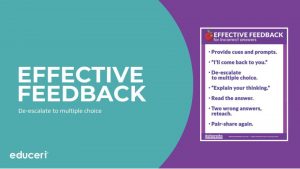Transforming Mistakes into Opportunities for Growth – Corrective Feedback
As educators, we all encounter moments when students struggle to answer questions correctly. So, what can we do when they don’t get it right? How can we help them move from confusion to clarity? The answer lies in effective feedback when checking for understanding.
First, the questions you’re asking must be directly tied to the content you’ve taught. Equally important is providing multiple opportunities throughout the lesson to check for understanding.
Frequent checks for understanding not only help you track progress but also reveal when feedback is needed. By identifying areas of confusion in real-time, you can offer targeted, corrective feedback that helps students stay on track.
Effective feedback is key when a student answers incorrectly. It’s not just about pointing out mistakes—it’s about guiding students toward the correct answer with timely, specific, and supportive strategies. The goal is to help all students achieve 100% correct answers, with targeted support through feedback and repeated practice. Here are a few of our top feedback strategies:
 Provide Cues and Prompts.
Provide Cues and Prompts.
If students struggle to answer, you can provide hints to help them remember. You might refer to a gesture you used when teaching, or you might point to something specific from the lesson that will trigger their recall. For example, direct them to a table, chart, or related information on the board.
“I’ll Come Back to You.”
When students go blank and can’t respond, try saying,“I will come back to you.” Then, call on one or two other students. The original student hears the other students’ responses and can usually provide an answer by the time you get back to them.
De-Escalate the Question. Rephrase as Multiple Choice. 
This strategy changes the question from a “retrieve from memory” question to a “recognize the answer” question. It’s an easy way to differentiate and help struggling students succeed. For example, if your initial question is “How do you solve this addition problem?” and the student hems and haws, then you can say,
“Let me ask you this. Do you start by adding from the right or from the left?”
See effective feedback in action
By asking and answering many questions and aiming for 100% correct answers, we provide repeated exposure to the content while creating an environment where students can correct misunderstandings and arrive at the correct answer through thoughtful feedback and practice. This reduces the reliance on rote memorization. Instead, by encouraging students to think critically and apply the content through Checking for Understanding questions, we reinforce their learning and help integrate the material into their long-term memory. This is what we call true learning.
Let’s use these strategies to upgrade our feedback and boost student learning!
For more information about our Effective Feedback workshop or our bestselling books on Explicit Direct Instruction, contact us at info@dataworks-ed.com or call 800-495-1550.




